Culinary Masterclass 3 - Hodge Podge
It's no coincidence that the Hotpot became a particularly widespread dish in Lancashire.
Once upon a time a Lady of Lancashire would have cooked her family's mutton supper like any regular northern lass - frying, roasting or stewing it over the fire whilst spinning wool with her foot treadle and tending to her latest baby with a free hand.
With the arrival of American cotton and the Industrial Revolution though, these stalwarts of the cottage industry were reluctantly indentured into the giant Cotton Mills sprouting up over the land like mushrooms, along with most of their children.
And so they were forced to adopt the practice of layering mutton, vegetables and sliced potatoes into a clay pot to drop off at the local bakery on their way to work;
where it could spend the rest of the day cooking in the bread oven's residual heat to be collected again, braised to perfection, on the way home from the mill. Allegedly.
Family dinner was saved!
Lancashire was a natural location for the development of mechanical textile processing due to its Eastern ports - handy for American trade, the pre-existing skill-base of weaving and spinning local wool and flax, its extensive canal transport system, the abundant clean running water for washing the cotton and driving the mills, and later its coal deposits for firing the giant engines of change.
The written history of Lancashire Hotpot is somewhat truncated, however.
The first mention in print seems to have been a letter from 'A Lancashire Man' reproduced in the 1795 'Annals of agriculture' where it is described as being like a poor man's pie;
British Hotchpot recipes go back as far as The Closet Of Sir Kenelm Digby Knight, Opened of 1669,
but here's one for Hodge-Podge from The Lady’s Own Cookery Book, and New Dinner-Table Directory of 1844:
Anyway, that's our dish for the day:
Once upon a time a Lady of Lancashire would have cooked her family's mutton supper like any regular northern lass - frying, roasting or stewing it over the fire whilst spinning wool with her foot treadle and tending to her latest baby with a free hand.
With the arrival of American cotton and the Industrial Revolution though, these stalwarts of the cottage industry were reluctantly indentured into the giant Cotton Mills sprouting up over the land like mushrooms, along with most of their children.
And so they were forced to adopt the practice of layering mutton, vegetables and sliced potatoes into a clay pot to drop off at the local bakery on their way to work;
where it could spend the rest of the day cooking in the bread oven's residual heat to be collected again, braised to perfection, on the way home from the mill. Allegedly.
Family dinner was saved!
Lancashire was a natural location for the development of mechanical textile processing due to its Eastern ports - handy for American trade, the pre-existing skill-base of weaving and spinning local wool and flax, its extensive canal transport system, the abundant clean running water for washing the cotton and driving the mills, and later its coal deposits for firing the giant engines of change.
The written history of Lancashire Hotpot is somewhat truncated, however.
The first mention in print seems to have been a letter from 'A Lancashire Man' reproduced in the 1795 'Annals of agriculture' where it is described as being like a poor man's pie;
... consisting of a trifling portion of beef or mutton, either raw or boiled, cut into small pieces and mixed in a dish of sliced potatoes,
proportioned to the size of the family, to which you add pepper and salt and a little water with butter or dripping, as gravy, the wholesome and savoury addition of a shred onion is often made, and gives a good relish
— the dish of hot pot, or lob scouce, as termed by sailors, is composed of the same ingredients, except a crust, and that it is simmered over the fire in a pan or in a pipkin in an oven, instead of baking.
The name of the dish is most probably derived from the word Hodge-Podge, or the Old French hochepot meaning a stew or a soup cooked in a pot and portioned out to diners.British Hotchpot recipes go back as far as The Closet Of Sir Kenelm Digby Knight, Opened of 1669,
but here's one for Hodge-Podge from The Lady’s Own Cookery Book, and New Dinner-Table Directory of 1844:
Stew a scrag of mutton: put in a peck of peas, a bunch of turnips cut small, a few carrots, onions, lettuce, and some parsley.
When sufficiently boiled add a few mutton chops, which must stew gently till done.
Sound familiar?Anyway, that's our dish for the day:
menu
A Hodge-Podge
Lancashire Hotpot
Lancashire Hotpot
A classic lamb stew with its signature tiled potato topping.
Braised Red Cabbage
Red cabbage braised in a grease-cutting gastrique.
Lancashire Hotpot
main meat
Once upon a time Lancashire Hotpot would have been made from a cheap cut of mutton a sheep more than 2 years old, but you might struggle to find mutton these days, so we used lamb.
You could use scrag end from the lamb's collar or middle neck (also just called neck - which is what we used) to be authentic, though shoulder or even best end cuts would also work.
In the those olden times they would also have thrown in pretty much anything else they could get their hands on, including oysters. Which apparently were plentiful and cheap in those days.
How times change eh?
You could add some Worcestershire sauce, which has a bit of anchovy in it, or some oriental fish sauce if you were really adventurous.
A few chopped lamb's kidneys and slices of black pudding are also not uncommon additions.
Here Lee takes a few liberties with the traditional recipe.
The dish would have been cooked entirely in the oven, and contain little more in the way of vegetables than potato and onion. Possibly carrot.
Definitely not tomato, nor mirepoix 🙂
You could use scrag end from the lamb's collar or middle neck (also just called neck - which is what we used) to be authentic, though shoulder or even best end cuts would also work.
In the those olden times they would also have thrown in pretty much anything else they could get their hands on, including oysters. Which apparently were plentiful and cheap in those days.
How times change eh?
You could add some Worcestershire sauce, which has a bit of anchovy in it, or some oriental fish sauce if you were really adventurous.
A few chopped lamb's kidneys and slices of black pudding are also not uncommon additions.
Here Lee takes a few liberties with the traditional recipe.
The dish would have been cooked entirely in the oven, and contain little more in the way of vegetables than potato and onion. Possibly carrot.
Definitely not tomato, nor mirepoix 🙂
Serves 2
Ingredients
- 200g lamb neck, cut into 1½" pieces
- oil for frying
- 1 small onion, diced
- 1 carrot, diced
- 1 stick celery, diced
- tablespoon of flour
- tablespoon or so of tomato purée
- 2 potatoes, thinly sliced
- thyme, leaves only
- stock, beef, chicken or even better - lamb!
Heat a chemise of oil in a large saucepan.
Add it to the pan and fry until the vegetables soften and begin to caramelize around the edges.
Stir in a tablespoon or two of flour to thicken the sauce and cook it for a minute, then a tablespoon or so of tomato purée and stir through again to cook off any harshness.
Strip some thyme leaves into the pan by pulling your fingers down the stalks towards the root.
Add enough stock to barely cover the meat and leave to simmer for 30 minutes.
Decant the meat and vegetables, with enough gravy to lubricate them, into an oven-proof dish.
Peel and thinly slice potatoes ideally using a mandoline and spiral them closely overlapping to completely cover the dish.
Season and brush with melted butter, then bake in a 170° fan/180°C Conventional/Gas Mark 5-6 oven for about 30 minutes until the thin potatoes are nicely crisped.
Give them another brush with melted butter and serve with a side of pickled or vinegar braised red cabbage.
If the pieces stick at first, they should naturally release themselves when the frying flesh is sufficiently scorched.
Although this will not actually seal the meat in any way, it does develop good flavour, and Lee suggests that it also helps the meat to hold its shape.
Which I had not previously considered.
Dice the onion, carrot and celery producing roughly equal volumes of each. This is a classic mirepoix.Although this will not actually seal the meat in any way, it does develop good flavour, and Lee suggests that it also helps the meat to hold its shape.
Which I had not previously considered.
Add it to the pan and fry until the vegetables soften and begin to caramelize around the edges.
Stir in a tablespoon or two of flour to thicken the sauce and cook it for a minute, then a tablespoon or so of tomato purée and stir through again to cook off any harshness.
Strip some thyme leaves into the pan by pulling your fingers down the stalks towards the root.
Add enough stock to barely cover the meat and leave to simmer for 30 minutes.
Decant the meat and vegetables, with enough gravy to lubricate them, into an oven-proof dish.
Peel and thinly slice potatoes ideally using a mandoline and spiral them closely overlapping to completely cover the dish.
Season and brush with melted butter, then bake in a 170° fan/180°C Conventional/Gas Mark 5-6 oven for about 30 minutes until the thin potatoes are nicely crisped.
Give them another brush with melted butter and serve with a side of pickled or vinegar braised red cabbage.
Many recipes cook the dish completely in the oven, at a slightly lower temperature (170°C conventional/Gas Mark 3½) and for much longer - 1-2 hours covered, then 30 minutes uncovered to brown.
Though possibly the mirepoix would not well survive this length of cooking.
You could also slide the dish under the grill to crisp up the potato topping at the end if they need it.
You could also slide the dish under the grill to crisp up the potato topping at the end if they need it.
Vinegar Braised Red Cabbage
side veg vegan
Gastrique is a classic French technique for creating a sweet-and-sour base for sauces.
It is usually always? made by first caramelizing honey or sugar, and then deglazing this with a small amount of vinegar.
I think what Lee actually directed us make is the Italian version - agrodolce - which is a syrupy reduction of sugar and vinegar.
Much more vinegar is involved because here the sugars are not caramelized and so retain their inherent sweetness, which requires more sourness to balance out the flavours.
Lee recommended using malt vinegar, which imparts an interesting flavour, though you might consider a cider vinegar.
It is usually always? made by first caramelizing honey or sugar, and then deglazing this with a small amount of vinegar.
I think what Lee actually directed us make is the Italian version - agrodolce - which is a syrupy reduction of sugar and vinegar.
Much more vinegar is involved because here the sugars are not caramelized and so retain their inherent sweetness, which requires more sourness to balance out the flavours.
Lee recommended using malt vinegar, which imparts an interesting flavour, though you might consider a cider vinegar.
Serves 2
Ingredients
- ¼ red cabbage, shredded
- ½ red onion, finely sliced
- ½ cup malt vinegar
- 100g brown sugar
- 1 tart apple, peeled, cored, sliced
Optional Spice:- stick of cinnamon
- bay leaf
- cloves
Heat malt vinegar with an equal amount of brown sugar in a pan until the sugar dissolves.
Simmer until the liquid becomes syrupy.
Lee was not forthcoming as to whether this meant equal volumes or equal weights.
You should adjust the proportions to your taste, but the general consensus seems to be equal volume.
Fortunately, one (U.S.) cup of brown sugar weighs approximately 200g (8oz), which is the volume of about ⅘th of a (U.S.) cup.
So it's almost the same by either measure!
Thinly slice the red cabbage and the red onion and stir into the boiling vinegar.
Season with salt and pepper and add spices like a bay leaf if you like.You should adjust the proportions to your taste, but the general consensus seems to be equal volume.
Fortunately, one (U.S.) cup of brown sugar weighs approximately 200g (8oz), which is the volume of about ⅘th of a (U.S.) cup.
So it's almost the same by either measure!
Simmer until the liquid becomes syrupy.
Careful though - if you let it reduce too hard the cabbage becomes somewhat leathery.
In which case you might be able to soften it back up by adding some water.
Peel a Granny Smith or other tart apple, cut it into quarters or eighths, remove the core portion, slice the rest thinly and add to the cabbage a couple of minutes before it is finished.
In which case you might be able to soften it back up by adding some water.
If you can get the apple peel off in a sufficiently long ribbon then you can roll it up tightly, and tuck under the other end, to make a decorative green rose!
Serve this astringent cabbage with rich meats or a nice Lancashire hotpot.
Very good!
On reflection, though, I don't recommend the cloves.
Unlike the bay leaf you can't easily separate them when the cabbage is cooked, and despite the complementary flavour, the odd mouthful of whole clove is not pleasant.
You could sprinkle over some clove powder if you liked instead?
On reflection, though, I don't recommend the cloves.
Unlike the bay leaf you can't easily separate them when the cabbage is cooked, and despite the complementary flavour, the odd mouthful of whole clove is not pleasant.
You could sprinkle over some clove powder if you liked instead?
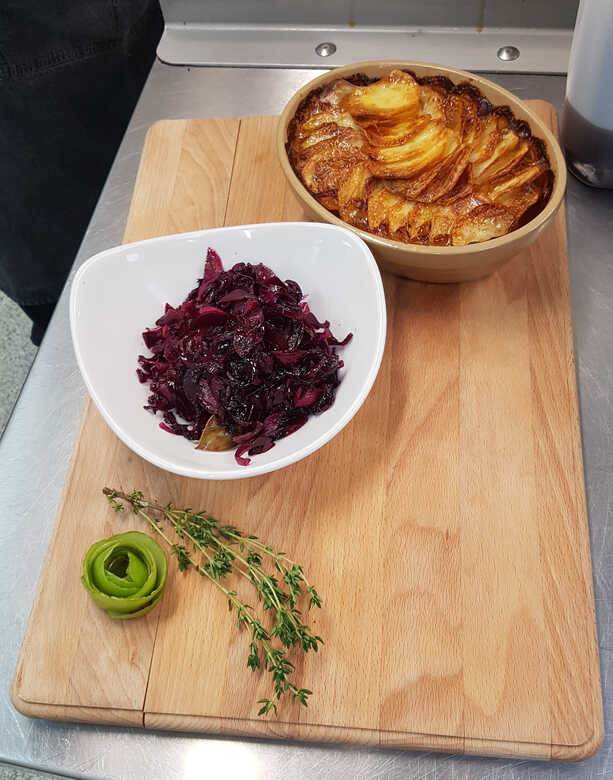
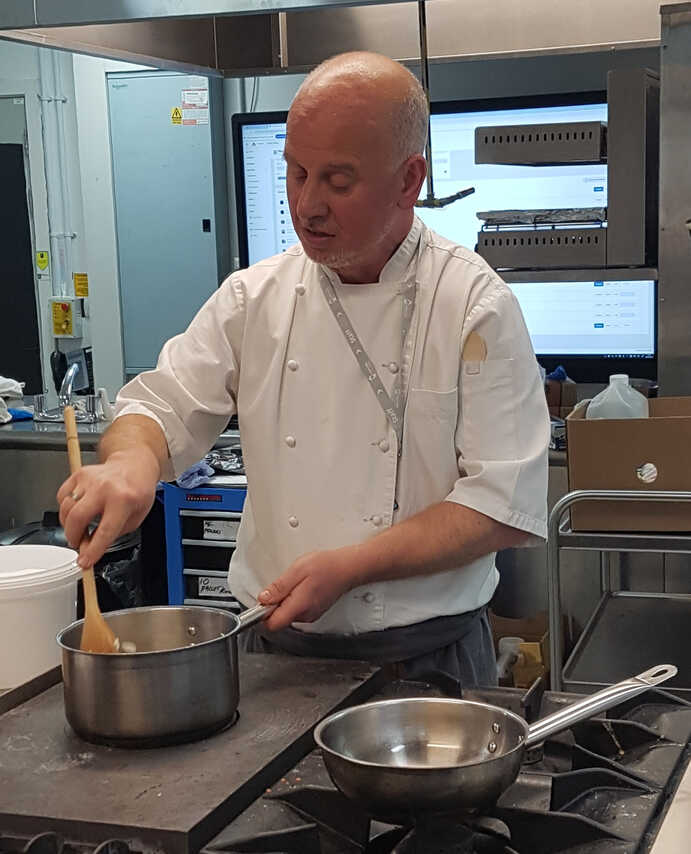
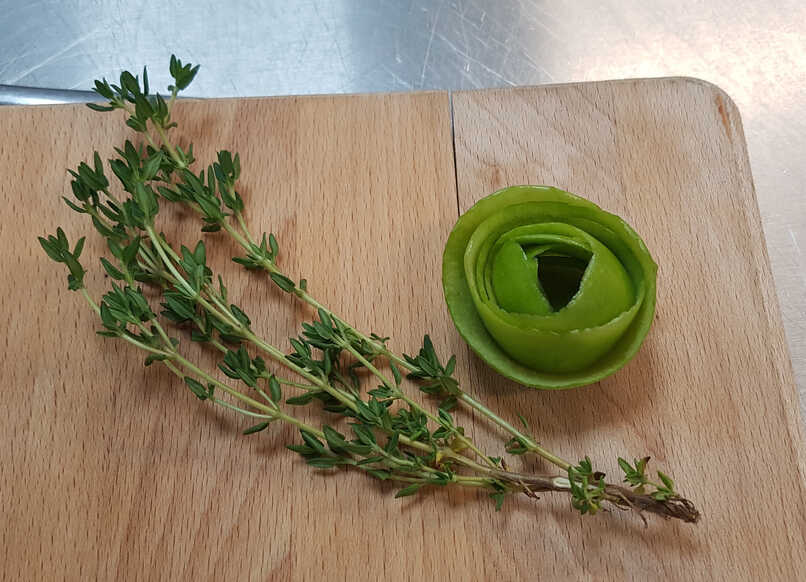
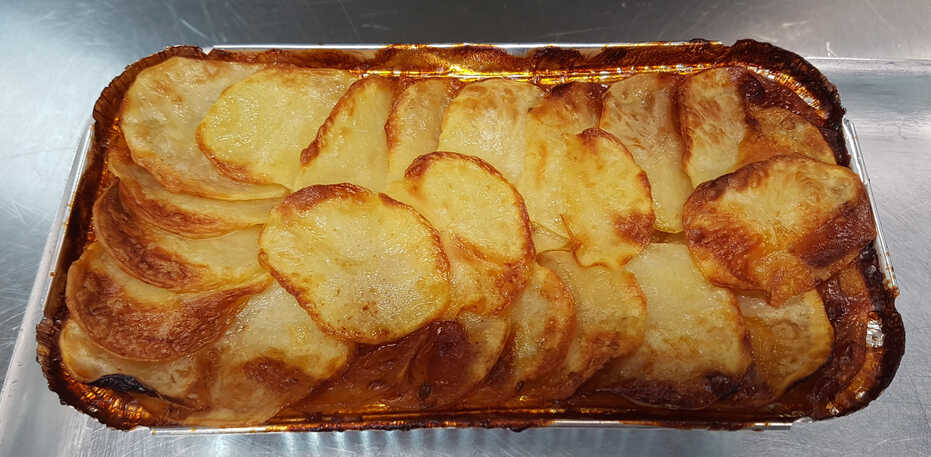
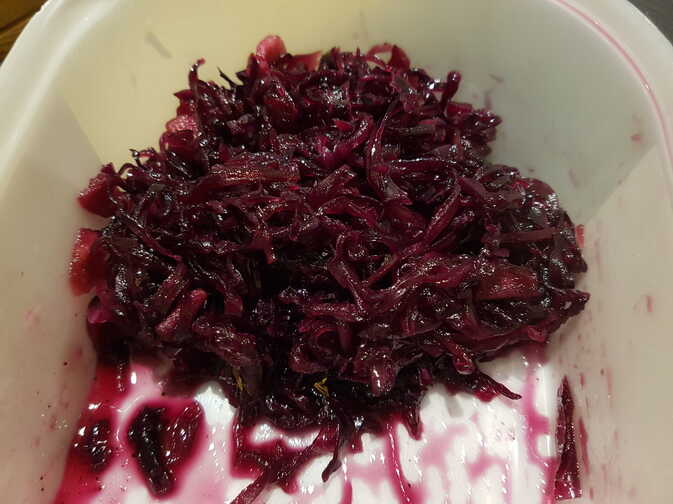
Or oil, in this case.